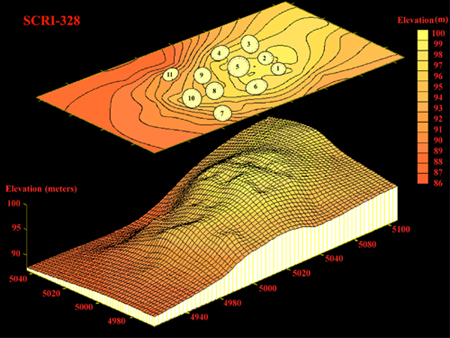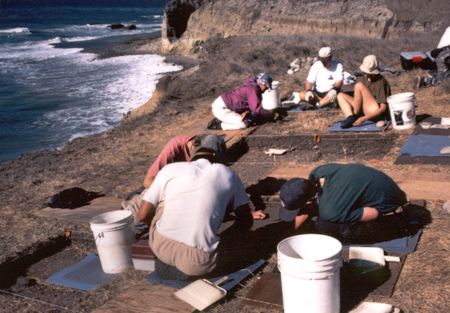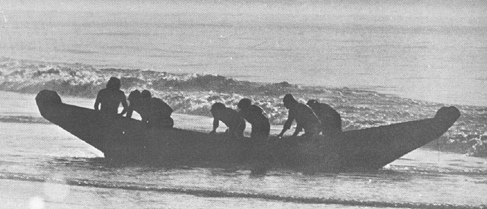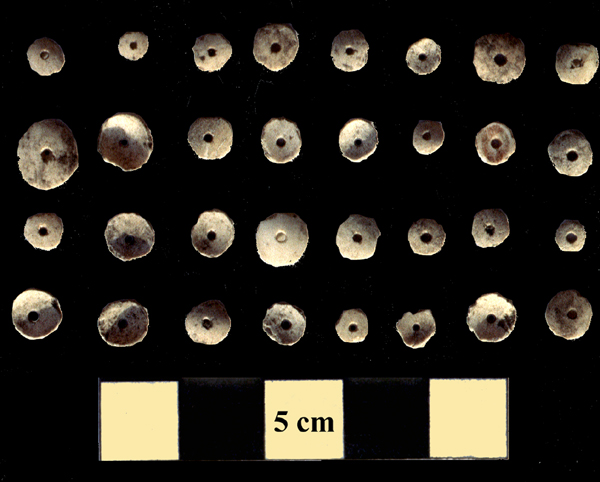|
Director: Jeanne
E. Arnold - E-mail: jearnold@ucla.edu
- Phone: 310.206.5801
|
| OVERVIEW |
|
Faculty, students, and research associates of the California Channel Islands Laboratory share the central goal of adding to our understanding of the more maritime-oriented and complex hunter-gatherers of the world, primarily those of the North American Pacific Coast. Projects have centered on topics such as specialized manufacturing (especially shellworking and lithic industries), how we can recognize the emergence of complex polities such as chiefdoms, exchange systems, households in the Historic period, technological innovations, the roles of fauna in emergent complexity, micromorphology, the paleoenvironment, and cooperative and competitive institutions. (right) Looking west over the northern Channel Islands: (front to back) Anacapa, Santa Cruz, Santa Rosa, and San Miguel. Photo © W. Dewey. |
.jpg) |
|
Over the past 20 years, Arnold has been engaged in empirical and theoretical investigations of the sociopolitical evolution of chiefdom-level societies, particularly complex hunter-gatherers in coastal California. The most recent field and lab project in California has been supported by the National Science Foundation and involved excavations at northern Channel Islands village sites dating to the terminus of the prehistoric era and the first half-century of intensive contact between indigenous peoples and Europeans (ca. A.D. 1700-1819). UCLA investigations encompassed about 35 households at several Historic-era village sites on Santa Cruz Island. Our theoretical focus includes exploration of social status, craft production, occupational specialization, and household organization and size. Several recent Ph.D. students employed project data for their theses or dissertations, including Anthony Graesch and Anna Noah. |
 |
|
A prominent Historic period community
on Santa Cruz Island. Digital maps by A. Graesch.
|
 |
UCLA Summer Field Schools in Archeology complemented the NSF project and supported excavations at one of the focal village sites. The NSF and field school research teams together recovered subsurface data from five households across three important villages and a combination of auger data and systematic surface-collected data from 35 houses at four villages. The surface data predict reasonably well the subsurface house contents, both qualitatively (kinds of artifacts dominating the assemblages) and quantitatively (density, intensity). |
|
1996 house excavations on the southern
coast of Santa Cruz Island. Photo by J. Arnold.
|
|
|
Island Chumash villagers were maritime peoples, engaged heavily in using the rich faunal resources of the Pacific Ocean and the Santa Barbara Channel. They traded extensively with their mainland Chumash neighbors across the channel, using their renowned plank canoes. They lived in large permanent communities, had hereditary leaders who were legitimate chiefs, and specialized in the manufacture of huge numbers of chert microdrills and Olivella shell beads as well as lesser numbers of other shell bead types. Graesch's thesis (2000, 2004) examines the inter-household variability in the production of shell beads and the acquisition of exotic trade materials, and Noah's dissertation (2005) focuses on different households' uses of animal resources and the potential to identify specialization and feasting in faunal assemblages. Many other analyses are ongoing.
|
|
 |
 |
|
Historic-Era Olivella wall beads.
Photo by A. Graesch.
|
|
An expanded treatment on the emergence of complex political and economic systems on the Channel Islands is available in the 2001 book The Origins of a Pacific Coast Chiefdom: The Chumash of the Channel Islands (edited by J.E. Arnold). See also the 2004 volume Foundations of Chumash Complexity (edited by J.E. Arnold, Cotsen Institute of Archeology). |
|